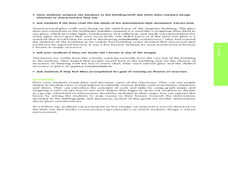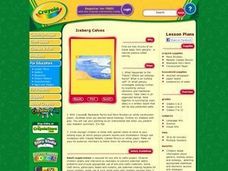New York City Department of Education
Colonial America and The American Revolution
How did the founding of the American colonies lead to a revolution? Use the essential question and sample activities to guide learners through a series of history lessons. Additionally, the packet includes effective strategies to...
Curated OER
Understanding Primary and Secondary Sources
Students identify legends in Tennessee and U.S. history, and differentiate between primary and secondary sources. They list examples of primary and secondary sources, participate in a field trip to the Country Music Hall of Fame, and...
Curated OER
African Art: Ntan Drum
Students study African history, anthropology and culture using the lens of the art object, Ntan Drum. Lesson and instruction is differentiated for elementary, middle and high school students.
Curated OER
Horse of a Different Color: An Introduction to Color in the Visual Arts
Students examine how artists use color to create a sense of depth in a two-dimensional space. They view and analyze prints, complete worksheets, and write a paragraph on how color is used to draw the viewer's eye to a central figure.
Curated OER
Midnight Ride of Paul Revere: Fact, Fiction, and Artistic License
Students examine The Midnight Ride of Paul Revere. For this visual arts lesson, students study the historical significance of the event as they examine the Grant Wood painting and primary sources regarding the event.
Curated OER
The Underground Railroad
High schoolers write about the impact of the Underground Railroad. They examine primary documents as they conduct independent research to explore the role of the Underground Railroad during the fight for abolition. They compose essays...
Curated OER
Transparency Review
Students investigate and distinguish between primary and secondary sources when analyzing works of literature. They present their information on transparencies that are displayed to the class.
Curated OER
Color Theory & Using Layers
Learners investigate the color wheel theory and incorporate it into simple sketches on their handheld. The importance of the use of layering and the difference between primary, secondary, and tertiary colors is presented in this lesson.
Curated OER
Compare Present Day Photographs to Historical Photographs from the Museum's Collection
Eighth graders discuss photojournalism and then compare present day to historical photographs. They discuss how photos capture daily life and historical events, compare historic photos to those seen today, then take and make a photo book...
Curated OER
In The Words of Abraham Lincoln...
Students explore the words of Abraham Lincoln. In this Abraham Lincoln lesson, students analyze segments of "The Gettysburg Address," his annual address to Congress in 1862, and his letter to Mrs. Bixby. Students conduct further research...
Curated OER
Exploring the Design Process
Students analyze the design process and architecture of Ludwig van der Rohe. In this architecture and art analysis lesson, students explore the design process through photographic documentation and architectural plans. Students use...
Curated OER
Battle Flags: Michigan and the Civil War Lesson 5 Letters from the War
Students investigate the letters written my Michigan soldiers during the Civil War. They examine the letters for clues about the life and attitudes of these soldiers.
Curated OER
Art: Iceberg Calves
Students in small groups, research icebergs, including where they are located and the sinking of the Titanic. In addition, they discover the process of calving. Then, using construction paper and paints, students draw and color pictures...
Curated OER
Childhood Lost: Child Labor in the United States, 1830-1930
Working in groups, middle and high schoolers describe and discuss photographs depicting working conditions experienced by child laborers in the 19th century. They then write a persuasive paragraph supporting an amendment to regulate the...
Curated OER
Influential People Taking A Stand
Seventh graders explore how influential people have taken a stand on difficult issues and the consequences that followed. This instructional activity connect American studens with students in England who present their own person for...
Curated OER
The Internet of Things: IoT
How has the Internet of Things affected our lives? Scholars examine the massive influence of mobile devices in this analysis activity, which begins with a seven-minute documentary clip. They also read a New York Times article (linked)...
Curated OER
Who Could Have Been Who
Can word choice affect a candidate's likeability? Use a New York Times lesson to explore how a presidential candidate's likeability factor can fluctuate in public opinion polls. Young readers choose a presidential election from their...
Concordia College Archives
Introduction and Student Inquiry
Introduce young musicians to the history of and different styles of music with an inquiry-based learning activity that asks them to play detectives to determine the similarities and differences among the sheet music found at a series of...
Alabama Department of Archives and History
Conflict in Alabama in the 1830s: Native Americans, Settlers, and Government
To better understand the Indian Removal Act of 1830, class members examine primary source documents including letters written by Alabama governors and the Cherokee chiefs. The lesson plan is part of a unit on the expansion of the United...
National Woman's History Museum
Defying British Rule: Women's Contributions to The American Revolution
Primary and secondary sources are the focus of a lesson that showcases the important role women played during the American Revolution. Pairs review sources and discuss their findings. A close-reading of an informational text leads the...
Library of Congress
George Washington: First in War, First in Peace, and First in the Hearts of His Countrymen
Does the lens of history portray George Washington as a good leader? A three-lesson unit looks at Washington's early military career as the commander of the Virginia Regiment, his role in the fight for independence from England, and his...
Curated OER
Understanding and Fighting Stereotypes through Words and Images
Use some provocative modern art to get your class considering stereotypes and the impact they have on us all. Your class will discuss the print art Indian Look-Alike by Melanie Yazzie and stereotypes in general before conducting research...
Curated OER
Frame Story "The Celebrated Jumping Frog of Calaveras County"
Mark Twain's frame story, "The Celebrated Jumping Frog of Calaveras County" provides an opportunity for a study of this story-within-a-story pattern. Using an illustrated template, class members record a plot summary of the frame story...
Curated OER
Teacher Appreciation Week (Elementary)
Primary writers will create a persuasive essay about Teacher Appreciation Week. Additionally, they will select a quote from a famous person and write a persuasive essay about how it relates to one of their favorite teachers. In the end,...
Other popular searches
- Art Lessons Primary Penguins
- Edible Art Lessons Primary
- Art Lessons Primary Easter
- 3d Art Lessons Primary
- Art Lessons Primary Fruit
- Winter Art Lessons Primary
- Maori Art Lessons Primary
- Visual Art Lessons Primary
- Art Lessons Primary Tiger
- Art Lessons Primary Water
- Art Lessons Primary Victoria
- Art Lessons Primary Art

























